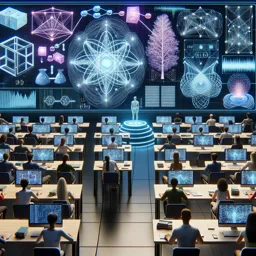
Free online courseIntroduction to Computational Thinking
Duration of the online course: 12 hours and 9 minutes
New course
Master computational thinking and data science with MIT's free online course. Dive into optimization problems, stochastic thinking, Monte Carlo simulations, machine learning, and more.
In this free course, learn about
- Optimization and Graph-Theoretic Foundations
- Stochastic Thinking and Random Processes
- Statistical Inference and Experimental Data
- Machine Learning, Classification, and Statistical Pitfalls
Course Description
Welcome to "Introduction to Computational Thinking," a comprehensive course that provides an enriching exploration into the world of Artificial Intelligence. With a total duration of 12 hours and 9 minutes, this course is a detailed journey through crucial concepts and methodologies that form the foundation of computational thinking and data science.
In this course, you will embark on a quest to demystify complex topics, starting with an introduction to optimization problems. Optimization forms the essence of computational strategy, where you'll learn to develop solutions that maximize or minimize specific objectives within given constraints. You’ll learn how essential this skill is when tackling real-world problems and computational tasks.
Following the optimization problems, the course delves into graph-theoretic models, providing insights into how nodes and connections form the basis of networks and their applications. This foundational knowledge will allow you to understand social networks, logistics, and even how information spreads through systems.
Moving forward, the course introduces you to stochastic thinking and random walks. These subjects will expose you to unpredictability and random events in systems, setting the stage for exploring the nature of randomness in computational problems and how Monte Carlo simulations can be used to model and predict outcomes in systems where random variables play a significant role.
With a solid grasp of stochastic techniques, you'll then study confidence intervals, learning how to quantify the uncertainty in your data and make informed predictions, a skill crucial for data scientists dealing with real-world data analysis.
The course also sheds light on sampling and standard error, facilitating your understanding of how to collect data samples and measure the precision of your estimates, leading to more accurate and reliable experimental outcomes.
Understanding experimental data is another cornerstone of computational thinking. This section is divided into two comprehensive parts, ensuring that you develop a robust ability to interpret, analyze, and draw conclusions from experimental datasets.
Diving into the realm of Artificial Intelligence, the course introduces you to machine learning. You will explore the principles behind machine learning algorithms and how they enable computers to learn from data and improve over time.
Next, clustering and classification will be key focus areas. You'll see how clustering algorithms can group similar data points, while classification techniques help assign data points to predefined categories. Both are pivotal in making sense of large datasets and uncovering hidden patterns.
Furthermore, the course touches on classification and statistical missteps, often termed statistical sins, and how to avoid them. This crucial knowledge will help you maintain the integrity and robustness of your data analyses.
Finally, the course wraps up by revisiting important concepts, ensuring all the crucial elements of computational thinking and data science are well understood and consolidated.
Embark on this journey through computational thinking and equip yourself with the knowledge and skills to tackle a myriad of data-driven problems in the field of Artificial Intelligence and beyond.
Course content
- Video class: 1. Introduction, Optimization Problems (MIT 6.0002 Intro to Computational Thinking and Data Science) 40m
- Exercise: _What is the goal of the problem sets in 60002?
- Video class: 2. Optimization Problems 48m
- Exercise: _What is the advantage of using a greedy algorithm?
- Video class: 3. Graph-theoretic Models 50m
- Exercise: _What is the purpose of MIT OpenCourseWare?
- Video class: 4. Stochastic Thinking 49m
- Exercise: _What is the reason why MIT OpenCourseWare asks for support from its users?
- Video class: 5. Random Walks 49m
- Exercise: _What is the purpose of defining the "Location" abstraction in the simulation of the drunk's walk?
- Video class: 6. Monte Carlo Simulation 50m
- Exercise: _Who invented the concept of Monte Carlo simulation?
- Video class: 7. Confidence Intervals 50m
- Exercise: _What is the purpose of the weights keyword argument in the pylab.hist function?
- Video class: 8. Sampling and Standard Error 46m
- Exercise: _What is the key idea behind simple random sampling?
- Video class: 9. Understanding Experimental Data 47m
- Exercise: _What is the purpose of MIT OpenCourseWare?
- Video class: 10. Understanding Experimental Data (cont.) 50m
- Exercise: _What is the objective function used in linear regression to measure the goodness of fit between observed and predicted data?
- Video class: 11. Introduction to Machine Learning 51m
- Exercise: _What is the purpose of clustering in machine learning?
- Video class: 12. Clustering 50m
- Exercise: _What is clustering in machine learning?
- Video class: 13. Classification 49m
- Exercise: What is a primary advantage of K nearest neighbors (KNN) in classification tasks?
- Video class: 14. Classification and Statistical Sins 49m
- Exercise: _What does the speaker suggest students do with the code provided for the final exam?
- Video class: 15. Statistical Sins and Wrap Up 44m
- Exercise: _What is the statistical sin being committed when people draw a conclusion by finding two points that are consistent with something they believe?
This free course includes:
12 hours and 9 minutes of online video course
Digital certificate of course completion (Free)
Exercises to train your knowledge
100% free, from content to certificate
Ready to get started?Download the app and get started today.
Install the app now
to access the courseOver 5,000 free courses
Programming, English, Digital Marketing and much more! Learn whatever you want, for free.
Study plan with AI
Our app's Artificial Intelligence can create a study schedule for the course you choose.
From zero to professional success
Improve your resume with our free Certificate and then use our Artificial Intelligence to find your dream job.
You can also use the QR Code or the links below.

More free courses at Artificial Intelligence

Free CourseDeep Learning With PyTorch

3h39m

19 exercises

Free CourseGoogle Prompting Essentials

3h24m

10 exercises

Free CourseHow to Build Chatbots

3h16m

6 exercises

Free CourseChat GPT and OpenAI API course

5h17m

Free CourseData Science

5h58m

38 exercises

Free CourseArtificial intelligence

12h40m

7 exercises

Free CourseData Science full course

11h22m

Free CourseR programming for Data Science

1h07m

6 exercises

Free CourseMachine Learning for complete beginners

1h09m

17 exercises

Free CourseFundamentals of Artificial Intelligence

25h26m

34 exercises

Free CourseDeep Learning With PyTorch
3h39m
19 exercises

Free CourseGoogle Prompting Essentials
3h24m
10 exercises

Free CourseHow to Build Chatbots
3h16m
6 exercises

Free CourseChat GPT and OpenAI API course
5h17m

Free CourseData Science
5h58m
38 exercises

Free CourseArtificial intelligence
12h40m
7 exercises

Free CourseData Science full course
11h22m

Free CourseR programming for Data Science
1h07m
6 exercises

Free CourseMachine Learning for complete beginners
1h09m
17 exercises

Free CourseFundamentals of Artificial Intelligence
25h26m
34 exercises
Free Ebook + Audiobooks! Learn by listening or reading!
Download the App now to have access to + 5000 free courses, exercises, certificates and lots of content without paying anything!
-
100% free online courses from start to finish
Thousands of online courses in video, ebooks and audiobooks.
-
More than 60 thousand free exercises
To test your knowledge during online courses
-
Valid free Digital Certificate with QR Code
Generated directly from your cell phone's photo gallery and sent to your email

Download our app via QR Code or the links below::.







